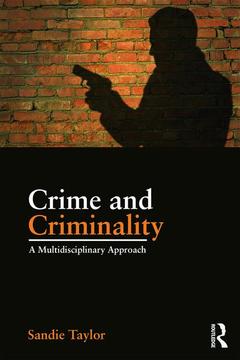Crime and Criminality A multidisciplinary approach
Auteur : Taylor Sandie

The question of ?why? and ?how? certain individuals are drawn towards behaving in a way that contravenes the ?Law of the Land? is not an easy one to address. Researchers from various different fields have nevertheless attempted to develop theoretical explanations for the existence of different types of crime and why some individuals commit such acts. Crime and Criminality draws on criminology, sociology, psychology and neuroscience to offer a balanced perspective of crime, the criminal and criminality. Coverage includes:
- a comprehensive discussion of theoretical approaches to criminal behaviour, including biological, social and ?rational choice? approaches;
- an analysis of legal and social definitions of crime and how these definitions influence the way specific behaviours are labelled as criminal;
- an examination of different types of crime and criminals, from delinquents to ?psychopaths? and sex offenders;
- an exploration of different ways in which crime is predicted, including risk assessment and offender profiling and an overview of investigative techniques.
Addressing a broad range of topics and offering a synthesis of competing theoretical explanations of criminality, this book is essential reading for students taking courses in criminology, criminal psychology, criminal behaviour, forensic psychology and psychological criminology.
Introduction Section 1: What is crime? 1. Defining and Examining Crime from Different Perspectives 2. Concepts in Crime Definition Influencing Crime Classification Section 2: Nature-Nurture Explanations of Criminal Behaviour 3. Biological Constraints and Evolutionary Factors 4. Social, Learning and Developmental Approaches to Understanding Criminality 5. Decision-Making Processes by Criminals Section 3: Different Types of Crime and Criminal as Evidence of Nature, Nurture or Nature-Nurture 6. White-Collar Criminals and their Crimes 7. Psychopaths and their Crimes 8. Sex Offenders and their Crimes 9. Female Offenders and their Crimes 10. Delinquents and their Crimes Section 4: Prediction of Criminal Behaviour 11. Dangerousness, Risk Assessment and the Mentally and the Personality Disordered Offender 12. Offender Profiling: Serial Killers Section 5: Reliability of Investigative Processes 13. Eye-witness Testimony and Extra-legal Defendant Characteristics 14.Cognitive Interview 15. Confessions Section 6: Discussion about the Function of Law and its Impact on Antisocial Behaviour an its Origins 16. 'Big 5' Legal Concepts 17. Law Drives Criminality 18. Concluding Comments.
Sandie Taylor was a senior lecturer in psychology at Bath Spa University until late 2012. Sandie's teaching and research interests overlapped between forensic/investigative/criminological psychology and developmental/biological psychology. Specialist areas of teaching and research included forensic, criminological and investigative psychology. Sandie is currently a visiting lecture in psychology at the University of South Wales and a freelance writer on psychology.
Date de parution : 11-2015
15.6x23.4 cm
Date de parution : 12-2015
15.6x23.4 cm
Disponible chez l'éditeur (délai d'approvisionnement : 14 jours).
Prix indicatif 214,69 €
Ajouter au panierThèmes de Crime and Criminality :
Mots-clés :
Sex Oender; Criminal Psychology; Young Men; Psychological Criminology; Human Moral Code; Forensic Psychology; Dangerous Oenders; Psychology of Crime; White Collar Criminals; Standard Police Interview; Criminal Psychopaths; Criminal Behaviour; Mala Prohibita; Sexual Oences; Serial Killers; Mens Rea; Police Ocers; Art Programme; Van Goozen; Violent Oenders; Nature Nurture Interaction; Police Interviewers; Eyewitness Memory; Facial Composite; Criminal Personality; Ventromedial Prefrontal Cortex; Oending Behaviour; Antisocial Behaviour; Criminal Parents



